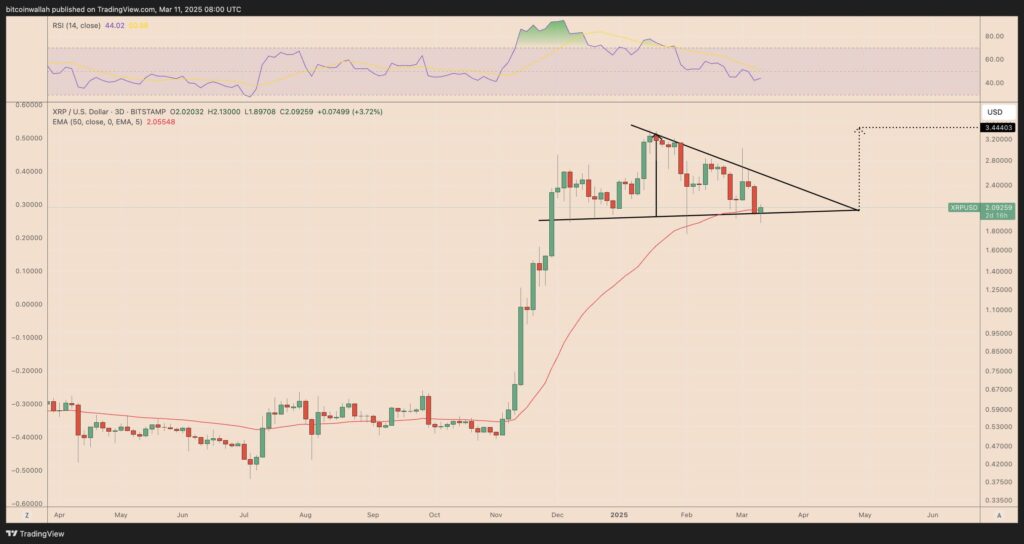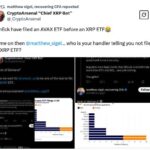The cryptocurrency market is experiencing notable turbulence, as XRP (XRP) joins the downward trend observed across the industry. On March 11, XRP’s price fell by approximately 7.50%, landing at .08 after hitting an intraday low of .90. This decline follows a broader market sell-off attributed to rising fears of a potential U.S. recession, which has left many investors on edge.
“Escalating concerns over a potential US economic slowdown have dampened investor sentiment across financial markets, hurting XRP and the broader cryptocurrency sector,”
Recent analysis by JPMorgan has indicated a heightened recession risk of 40%, up from 30%, while Goldman Sachs has similarly increased its projections. This alarming economic climate was exacerbated by President Trump’s remarks about a “period of transition” and new tariffs on imports from key trading partners, fueling anxieties about a global trade war.
As worries mount, investors are gravitating toward “safe havens,” leading to significant declines in both tech stocks and cryptocurrency markets. The Nasdaq E-Mini Futures dropped nearly 6% last week, mirroring a substantial 8.85% contraction in the total cryptocurrency market cap. Meanwhile, traditional currencies like the Euro and Japanese Yen have shown signs of resilience against the U.S. dollar.
“XRP’s price took a sharp hit following the White House’s inaugural Crypto Summit on March 7, as hopes for its inclusion in a US strategic crypto reserve were swiftly dashed,”
Adding to XRP’s woes, the recent White House Crypto Summit did not provide the expected support for the coin, as key officials clarified that XRP was simply an illustrative example and not a part of the U.S. reserve strategy. This clarification has left investors concerned about XRP’s future prospects, especially compared to Bitcoin, which is backed by significant government holdings.
The technical outlook for XRP appears concerning, as it has formed a head-and-shoulders pattern—a classic bearish signal in technical analysis. Should the price slide below the noted neckline support around , analysts suggest the cryptocurrency could plummet as much as 45% by April. However, a rebound from this support could potentially delay this bearish trend and offer a chance for recovery.
As the market navigates these choppy waters, the future holds uncertainty for XRP and its investors. Many are left wondering whether the coin can regain its footing amid prevailing economic fears and technical challenges.
XRP Price Decline and Market Influences
The significant drop in XRP’s price is alarming for investors and reflects broader economic concerns. Here are the key points that outline the current situation and its potential impacts:
- Price Movement
- XRP’s price fell by approximately 7.50% in 24 hours, currently at .08, with a low of .90.
- Economic Concerns
- Heightened fears of a US recession are dampening investor sentiment across financial markets.
- JPMorgan raised the US recession risk to 40%, increasing concerns over extreme US policies.
- White House policies, including tariffs imposed by President Trump, are raising fears of a global trade war.
- Goldman Sachs has also raised its recession probability forecast, indicating a broader market pessimism.
- White House Crypto Summit Impact
- The inaugural Crypto Summit failed to provide optimistic news for XRP, as illustrated by the lack of inclusion in a proposed US strategic crypto reserve.
- The clarification by President Trump’s team stating that XRP was only an illustrative example decreased investor optimism.
- As Bitcoin sees institutional support, the outlook for XRP remains uncertain.
- Technical Analysis
- XRP is forming a head-and-shoulders pattern that could indicate a further decline of up to 45% if it breaks below the key support level around .
- A decisive rebound from this support could delay the bearish pattern and potentially lead to a bullish breakout scenario.
Understanding these factors is crucial for investors as they navigate the volatile cryptocurrency landscape. Economic indicators and geopolitical developments can significantly affect market sentiment and individual asset prices.
Analyzing XRP’s Market Struggles Amidst Economic Fears
The recent bearish trend for XRP highlights significant challenges that mirror those facing much of the cryptocurrency market. On March 11, XRP experienced a notable decline, with its value plunging by approximately 7.50%. This downward momentum can be attributed to several key factors influencing investor sentiment, including heightened US recession fears and disappointing news surrounding governmental support for digital assets.
Competitive Advantages: One of the primary competitive advantages of XRP lies in its established positioning within the cryptocurrency market. Despite the current downturn, XRP has maintained a robust infrastructure and utility-focused approach, which could appeal to institutional investors once market stability returns. Additionally, XRP’s performance is often compared to Bitcoin’s, which, despite its own fluctuations, continues to represent a safer bet for risk-averse investors looking for cryptocurrency volatility mitigation.
Competitive Disadvantages: On the flip side, XRP faces significant hurdles that could deter potential investors. The lack of concrete governmental backing has led to decreased confidence. Unlike Bitcoin, which has a substantial government-held reserve, XRP’s absence from the US strategic crypto reserves reveals a vulnerability that could dissuade large-scale investment. Furthermore, the recent unfavorable news from the White House Crypto Summit has left a vacuum of investor optimism, especially considering the growing sentiment that traditional financial markets are favoring other currencies like Ethereum and Solana.
This situation could either benefit or create problems for various stakeholders in the cryptocurrency ecosystem. For institutional investors, the current landscape presents both an opportunity and a risk. A potential rebound from these lows could motivate them to accumulate more XRP at a discounted rate, positioning themselves favorably when a market recovery happens. However, persistent bearish sentiment bolstered by recession fears could further discourage investment, particularly as investor focus shifts to perceived safe havens like gold or index funds.
Retail investors could find themselves in a precarious situation. While the current prices may seem attractive, the looming head-and-shoulders pattern suggests that XRP could plunge further, creating a potential loss for those who buy in now. Additionally, educational efforts around the volatility of cryptocurrency need to be amplified to ensure that retail participants can make informed decisions amidst prevailing market uncertainties.
In summary, while XRP continues to maintain a presence in the cryptocurrency market, the current economic climate poses both risks and opportunities for various types of investors. The balance between fear and potential growth will undoubtedly shape the future trajectory of XRP in the coming weeks.

















